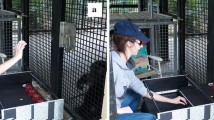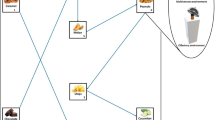Abstract
We investigated whether chimpanzees, bonobos, and orangutans encoded the location of a reward hidden underneath one of three identical cups in relation to (1) the other cups in the array—i.e., the relative position of the baited cup within the array; or (2) the landmarks surrounding the cups—e.g., the edge of the table. Apes witnessed the hiding of a food reward under one of three cups forming a straight line on a platform. After 30 s, they were allowed to search for the reward. In three different experiments, we varied the distance of the cups to the edge of the platform and the distance between the cups. Results showed that both manipulated variables affected apes’ retrieval accuracy. Subjects’ retrieval accuracy was higher for the outer cups compared with the Middle cup, especially if the outer cups were located next to the platform’s edge. Additionally, the larger the distance between the cups, the better performance became.






Similar content being viewed by others
References
Albiach-Serrano A, Call J, Barth J (2010) Great Apes track hidden objects after changes in the objects’ position and in subject’s orientation. Am J Primatol 72:349–359
Barth J, Call J (2006) Tracking the displacement of objects: a series of tasks with Great Apes (Pan troglodytes, Pan paniscus, Gorilla gorilla, and Pongo pygmaeus) and Young Children (Homo sapiens). J Exp Psychol Anim Behav Process 32:239–252
Bennett ATD (1993) Spatial memory in a food storing corvid. I. Near tall landmarks are primarily used. J Comp Physiol A Sens Neural Behav Physiol 173:193–207
Beran MJ, Beran MM, Menzel CR (2005) Spatial memory and monitoring of hidden items through spatial displacements by Chimpanzees (Pan troglodytes). J Comp Psychol 119:14–22
Biegler R, Morris RGM (1999) Blocking in the spatial domain with arrays of discrete landmarks. J Exp Psychol Anim Behav Process 25:334–351
Brodbeck DR (1994) Memory for spatial and local cues—a comparison of a storing and a nonstoring species. Anim Learn Behav 22:119–133
Bullens J, Nardini M, Doeller CF, Braddick O, Postma A, Burgess N (2010) The role of landmarks and boundaries in the development of spatial memory. Dev Sci 13:170–180
Burgess N (2006) Spatial memory: how egocentric and allocentric combine. Trends Cognit Sci 10:551–557
Call J (2001) Object Permanence in Orangutans (Pongo pygmaeus), Chimpanzees (Pan troglodytes), and children (Homo sapiens). J Comp Psychol 115:159–171
Cheng K, Newcombe NS (2005) Is there a geometric module for spatial orientation? Squaring theory and evidence. Psychon Bull Rev 12:1–23
Cheng K, Sherry DF (1992) Landmark-based spatial memory in birds (Parus atricapillus and Columba livia): the use of edges and distances to represent spatial positions. J Comp Psychol 106:331–341
Cheng K, Spetch ML (1998) Mechanisms of landmark use in mammals and birds. In: Healy S (ed) Spatial representation in animals. Oxford University Press, Oxford, pp 1–17
Chiandetti C, Regolin L, Sovrano VA, Vallortigara G (2007) Spatial reorientation: the effects of space size on the encoding of landmark and geometry information. Anim Cogn 10:159–168
Church DL, Plowright CMS (2006) Spatial encoding by Bumblebees (Bombus impatiens) of a reward within an artificial flower array. Anim Cogn 9:131–140
de Blois ST, Novak MA (1994) Object permanence in Rhesus Monkeys (Macaca mulatta). J Comp Psychol 108:318–327
de Blois ST, Novak MA, Bond M (1998) Object permanence in Orangutans (Pongo pygmaeus) and Squirrel Monkeys (Saimiri sciureus). J Comp Psychol 112:137–152
Deipolyi A, Santos L, Hauser MD (2001) The role of landmarks in cotton-top tamarin spatial foraging: evidence for geometric and non-geometric features. Anim Cogn 4:99–108
DeLoache JS, Brown AL (1983) Very young children’s memory for the location of objects in a large-scale environment. Child Dev 54:888–897
Deppe AM, Wright PC, Szelistowski WA (2009) Object permanence in Lemurs. Anim Cogn 12:381–388
Dolins FL (2009) Captive Cotton-Top Tamarins’ (Saguinus oedipus oedipus) use of landmarks to localize hidden food items. Am J Primatol 71:316–323
Fedor A, Skollár G, Szerencsy N, Ujhelyi M (2008) Object permanence Tests on Gibbons (Hylobatidae). J Comp Psychol 122:403–417
Fiset S, Dore FY (1996) Spatial encoding in domestic cats (Felis catus). J Exp Psychol Anim Behav Process 22:420–437
Fiset S, Gagnon S, Beaulieu C (2000) Spatial encoding of hidden objects in dogs (Canis familiaris). J Comp Psychol 114:315–324
Garber PA, Paciulli LM (1997) Experimental field study of spatial memory and learning in wild Capuchin Monkeys (Cebus capucinus). Folia Primatol 68:236–253
Gibbs S, Lea S, Jacobs L (2007) Flexible use of spatial cues in the Southern flying squirrel (Glaucomys volans). Anim Cogn 10:203–209
Goodyear AJ, Kamil AC (2004) Clark’s Nutcrackers (Nucifraga columbiana) and the effects of goal-landmark distance on overshadowing. J Comp Psychol 118:258–264
Gouteux S, Thinus-Blanc C, Vauclair J (2001) Rhesus monkeys use geometric and nongeometric information during a reorientation task. J Exp Psychol Gen 130:505–519
Haun DBM, Call J (2009) Great Apes’ capacities to recognize relational similarity. Cognition 110:147–159
Haun DBM, Call J, Janzen G, Levinson SC (2006a) Evolutionary psychology of spatial representations in the Hominidae. Curr Biol 16:1736–1740
Haun DBM, Rapold CJ, Call J, Janzen G, Levinson SC (2006b) Cognitive Cladistics and Cultural Override in Hominid Spatial Cognition. Proc Natl Acad Sci USA 103:17067–17068
Herrmann E, Call J, Hernández-Lloreda MV, Hare B, Tomasello M (2007) Humans have evolved specialized skills of social cognition: the cultural intelligence hypothesis. Science 317:1360–1366
Hoffman ML, Beran MJ (2006) Chimpanzees (Pan troglodytes) remember the location of a hidden food item after altering their orientation to a spatial array. J Comp Psychol 120:389–393
Hribar A, Haun D, Call J (2011) Great Apes’ strategies to map spatial relations. Anim Cogn, doi:10.1007/s10071-011-0385-6
Huttenlocher J, Newcombe N, Sandberg EH (1994) The coding of spatial location in young children. Cognit Psychol 27:115–147
Kanngiesser P, Call J (2010) Bonobos, Chimpanzees, Gorillas, and Orang Utans use feature and spatial cues in two spatial memory tasks. Anim Cogn 13:419–430
Kubo-Kawai N, Kawai N (2007) Interference effects by spatial proximity and age-related declines in spatial memory by Japanese Monkeys (Macaca fuscata): deficits in the combined use of multiple spatial cues. J Comp Psychol 121:189–197
Learmonth AE, Newcombe NS, Huttenlocher J (2001) Toddlers’ use of metric information and landmarks to reorient. J Exp Child Psychol 80:225–244
Legge ELG, Spetch ML, Batty ER (2009) Pigeons’ (Columba livia) hierarchical organization of local and global cues in touch screen tasks. Behav Process 80:128–139
MacDonald SE (1994) Gorillas’ (Gorilla gorilla gorilla) spatial memory in a foraging task. J Comp Psychol 108:107–113
MacDonald SE, Agnes MM (1999) Orangutan (Pongo pygmaeus abelii) spatial memory and behavior in a foraging task. J Comp Psychol 113:213–217
MacDonald SE, Wilkie DM (1990) Yellow-nosed monkeys’ (Cercopithecus ascanius whitesidei) spatial memory in a simulated foraging environment. J Comp Psychol 104:382–387
MacDonald SE, Spetch ML, Kelly DM, Cheng K (2004) Strategies in landmark use by children, adults, and Marmoset Monkeys. Learn Motiv 35:322–347
Marsh HL, Spetch ML, MacDonald SE (2011) Strategies in landmark use by orangutans and human children. Anim Cogn, doi:10.1007/s10071-011-0382-9
Martin-Ordas G, Haun D, Colmenares F, Call J (2010) Keeping Track of Time: Evidence for Episodic-Like Memory in Great Apes. Anim Cogn 13:331–340
Mendes N, Huber L (2004) Object permanence in Common Marmosets (Callithrix jacchus). J Comp Psychol 118:103–112
Menzel EW (1973) Chimpanzee spatial memory organization. Science 182:943–945
Menzel CR (1996) Spontaneous use of matching visual cues during foraging by long-tailed Macaques (Macaca fascicularis). J Comp Psychol 110:370–376
Newcombe NS, Huttenlocher J (2000) Making space: the development of spatial representation and reasoning. The MIT Press, Cambridge
Potì P (2000) Aspects of spatial cognition in Capuchins (Cebus apella) frames of reference and scale of space. Anim Cogn 3:69–77
Potì P, Bartolommei P, Saporiti M (2005) Landmark use by Cebus apella. Int J Primatol 26:921–948
Potì P, Kanngiesser P, Saporiti M, Amiconi A, Bläsing B, Call J (2010) Searching in the Middle-Capuchins’ (Cebus apella) and Bonobos’ (Pan paniscus) behavior during a spatial search task. J Exp Psychol Anim Behav Process 36:92–109
Shettleworth SJ (2010) Cognition, evolution, and behavior. Oxford University Press, New York
Simms N, Gentner D (2008) Spatial language and landmark use: can 3-, 4-, and 5-year-olds find the middle? In: Love BC, McRae K, Sloutsky VM (eds) Proceedings of the 30th annual conference of the cognitive science society. Cognitive Science Society, Austin, pp 191–196
Sovrano VA, Bisazza A, Vallortigara G (2007) How fish do geometry in large and in small spaces. Anim Cogn 10:47–54
Spetch SML, Edwards CA (1988) Pigeons’, Columba Livia, use of global and local cues for spatial memory. Anim Behav 36:293–296
Spetch ML, Kelly DM (2006) Comparative spatial cognition: processes in landmark- and surface-based place finding. In: Wasserman EA, Zentall TR (eds) Comparative cognition: experimental explorations of animal intelligence. Oxford University Press, New York, pp 210–228
Sutton JE, Olthof A, Roberts WA (2000) Landmark use by Squirrel Monkeys (Saimiri sciureus). Anim Learn Behav 28:28–42
Uttal DH, Sandstrom LB, Newcombe NS (2006) One hidden object, two spatial codes: young children’s use of relational and vector coding. J Cognit Dev 7:503–525
Vallortigara G, Zanforlin M (1986) Position learning in Chicks. Behav Process 12:23–32
Acknowledgments
This study was supported by the German Academic Exchange Service (DAAD) through a PhD grant to the first author. We thank Nathan Pyne-Carter for improving the English of the manuscript. The reported experiments comply with all laws of the country in which they were performed.
Author information
Authors and Affiliations
Corresponding author
Rights and permissions
About this article
Cite this article
Hribar, A., Call, J. Great apes use landmark cues over spatial relations to find hidden food. Anim Cogn 14, 623–635 (2011). https://doi.org/10.1007/s10071-011-0397-2
Received:
Revised:
Accepted:
Published:
Issue Date:
DOI: https://doi.org/10.1007/s10071-011-0397-2




